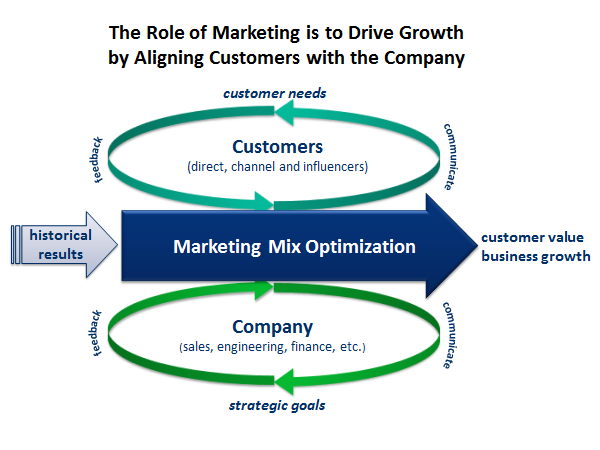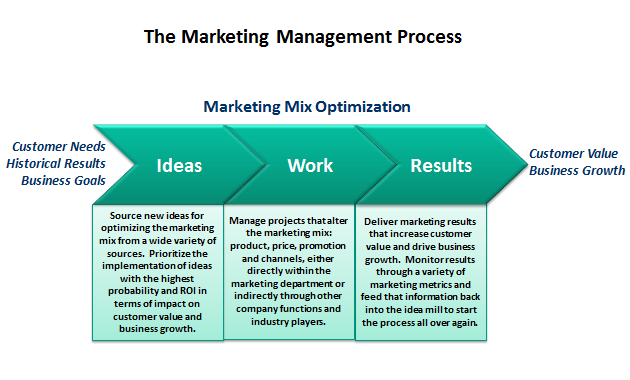The Marketing Management Process Defined
The marketing management process is hard to pin down. Marketing managers come in a bewildering variety: product marketers, online marketers, channel marketers, event marketers, market researchers, public relations managers, and so forth. They manage an even more bewildering variety of marketing projects from blog posts to product launches. Is there a method to their madness? Can we define a uniform marketing management process that applies to all marketing managers? In my humble opinion, the answer is yes.
The Role of Marketing in a Business
Before digging into the marketing management process, it’s probably a good idea to remind ourselves of the role marketing plays in a business. Many people think marketing is synonymous with advertising, branding or demand generation. The reason for this is that marketing communications is the most visible aspect of marketing to people outside the marketing department. However, marketing communications is only one component of the marketing mix.

Marketing is the process of getting the capabilities of the company aligned with the customer to deliver value and make money.
Marketing is first and foremost a process that every business must do, whether or not it has a marketing department. In plain English, marketing is the process of getting the capabilities of the company aligned with the customer to deliver value and make money. The marketing process itself consists of optimizing the four components of the marketing mix: product, pricing, promotions and channels for both delivery and communication. Since promotion is the most visible marketing activity to the outside world, non-marketers tend to equate marketing solely with promotion. Marketers should not. And regardless of your marketing role, you should not lose focus of the primary marketing goal: deliver customer value that makes money! (Or, just deliver customer value and break even if you are a non-profit marketer ;)).
The Fundamental Marketing Management Process
Different marketing management roles focus on different components of the marketing mix and approach the goal of delivering customer value from different angles. Sometimes marketing management focuses on communicating customer value through a specific media channel. Other times marketing management focuses on collecting feedback and understanding customer value to improve a product or adjust its price. And, because people outside the marketing department routinely engage in marketing activities, marketing management often focuses on facilitating marketing activities with sales, engineering, channel partners and industry influencers.

The marketing management process consists of the activities marketing managers do to optimize the marketing mix, including sourcing new marketing mix ideas, implementing them, analyzing the results, and doing it all over again.
As a function, marketing is nothing more than an information hub. It collects information about customer value, processes it to make adjustments to the marketing mix, and communicates it back to both customers and company in the interest of making money. The marketing management process simply facilitates this flow of information. As such, all marketing managers follow the same, fundamental marketing management process:
- Ideas: Source, prioritize and implement new ideas for optimizing the marketing mix that will have the biggest impact on customer value and business growth.
- Work: Manage projects that alter the marketing mix either directly within the marketing department or indirectly through other company functions and industry players.
- Results: Deliver marketing results that increase customer value and drive business growth. Monitor results through a variety of marketing metrics and feed that information back into the idea mill to start the process all over again.
At this point you might be thinking: “That’s great Joel, but it’s kind of generic. Can’t almost any job be described like this?” No. Most jobs are not “idea factories” in the same fashion as marketing management, because most jobs do not require constant realignment of many internal moving parts (marketing mix) to many external moving parts (customers). They have more clearly defined processes and goals, e.g., deliver a product, close a sale, or resolve a customer issue, as opposed to meet a new customer need, create a compelling message, or increase brand loyalty. Most jobs don’t have the nebulous boundaries of marketing management that entail large scale facilitation outside one’s own area. Marketing managers not only do marketing, but they routinely help others do marketing, such as helping sales better define the target customer or helping engineering decide what product features offer the most customer value.
Marketers must continually source new marketing mix ideas in the interest of growth, analyze and prioritize them, create plans to translate them onto reality, refine the ideas into finished marketing mix deliverables, and then get those deliverables to their intended audience inside or outside the company. The following examples illustrate the general marketing management process across a diverse set of specific marketing management roles.
The Content Marketing Management Process
Content marketers generate demand by educating customers about the value of a company’s products or services. For content marketing to be effective, the content marketer must provide a continuous flow of content. That flow of content is contingent on a continuous flow of new educational ideas that will be valuable in the eyes of the customer, because you can’t just keep saying the same thing over and over. These ideas may come from a wide variety of sources both inside and outside the marketing department, e.g., thought leadership positioning, customer case studies, product use and education, responses to competitor blog posts, etc. Then, they must be refined and prioritized based on the value of the content, the resources required to produce the content and the revenue impact of the content. Finally, getting it out the door will again require collaboration both inside and outside the marketing department, such as with a designer, a sales person, a customer or an industry influencer. Finally, some effort should be made to link the impact of the content marketing effort to business results. Wash, rinse, repeat.
The Product Marketing Management Process
Product managers increase customer value and drive growth by ensuring that products meet an ever expanding set of customer needs. To accomplish this, the product manager must source new ideas for meeting those needs from a wide variety of sources, including direct customer feedback, technology innovation, sales requests, competitor products and so forth. These ideas must be prioritized based on the customer value they deliver, the cost of implementing them and the revenue they will generate. Then, the product manager must refine the product requirements and work with a broad range of individuals both inside and outside the marketing department to realize their delivery to the customer, including engineering, manufacturing, sales, customer support, and say, content marketing and public relations. Then, the product manager will track the business results of product improvements through a combination of product-centric metrics and direct customer feedback. Wash, rinse, repeat.
The Channel Marketing Management Process
Channel marketing managers support channel partners by helping them do the same things that a direct marketing organization would do, only outsourced to a partner. As such, their role is almost entirely facilitation between the channel partner, the marketing department, and at times the entire company. Ideally, the channel marketing manager will provide a marketing blueprint to the channel partner consisting of new ideas that the channel partner can implement. The channel marketing manager will assist the channel partner in implementing these ideas. Then, the channel marketing manager will track the results of the various programs and projects through a combination of channel-specific metrics and direct feedback from channel partners. Wash, rinse, repeat.
The Public Relations Management Process
Public relations managers are charged with building a company’s brand and driving demand by soliciting and facilitating content created by third parties, e.g., journalists, bloggers, event organizers, analysts, marketing partners and industry influencers. Public relations managers accomplish this by developing story ideas from a wide range of sources: existing news flow, journalist requests, marketing communication goals, sales requests, and so forth. These story ideas must then be refined and evaluated based on the value that they will deliver to the final customer, the third party, and the business. Then the public relations manager must promote the ideas to the relevant third parties and help them bring the story to fruition. Finally, the public relations manager will track the results of these efforts on the business through PR-centric metrics and direct feedback from the various stakeholders. Wash, rinse, repeat.
In each marketing management role above, the fundamental marketing management process consisted of sourcing and prioritizing marketing ideas for optimizing the marketing mix, then turning the best of those ideas into concrete projects that produce value in the eyes of the customer and drive business growth. Along the way, each marketing manager was required to collaborate and communicate with customers and colleagues inside and outside the marketing department to get the job done. If your marketing team is not managing to this fundamental marketing management process, then they will lose focus of marketing fundamentals amid a sea of clicks, meetings, fire-fights and politics, and there will be no guarantee that marketing results will deliver customer value or drive business growth.
Joel York
Latest posts by Joel York (see all)
- Marketing Management Tactics for Quelling Public Unrest - February 11, 2017
- Avoiding Marketing Management Industrial Accidents - January 20, 2017
- Surviving Marketing Management Natural Disasters - December 13, 2016

1 Comment
[…] by stringing together a hodge-podge of marketing programs. Sustainable revenue growth requires a marketing management process that consistently discovers, optimizes and scales new sources of revenue. Is your marketing […]